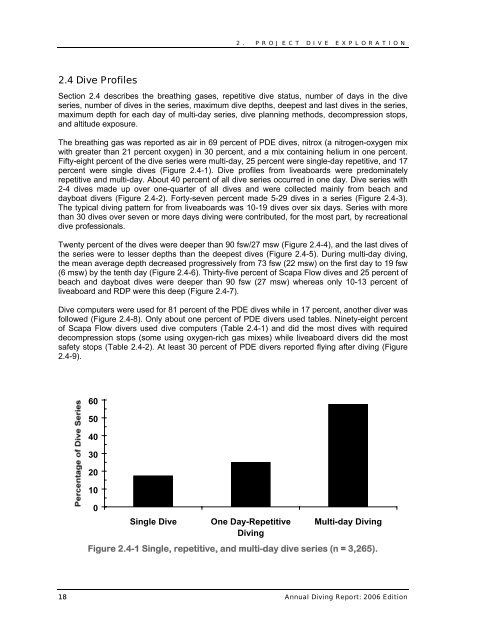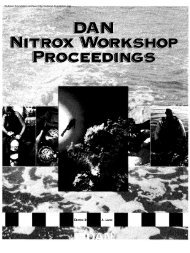Annual Diving Report - Divers Alert Network
Annual Diving Report - Divers Alert Network
Annual Diving Report - Divers Alert Network
You also want an ePaper? Increase the reach of your titles
YUMPU automatically turns print PDFs into web optimized ePapers that Google loves.
2.4 Dive Profiles<br />
2. PROJECT DIVE EXPLORATION<br />
Section 2.4 describes the breathing gases, repetitive dive status, number of days in the dive<br />
series, number of dives in the series, maximum dive depths, deepest and last dives in the series,<br />
maximum depth for each day of multi-day series, dive planning methods, decompression stops,<br />
and altitude exposure.<br />
The breathing gas was reported as air in 69 percent of PDE dives, nitrox (a nitrogen-oxygen mix<br />
with greater than 21 percent oxygen) in 30 percent, and a mix containing helium in one percent.<br />
Fifty-eight percent of the dive series were multi-day, 25 percent were single-day repetitive, and 17<br />
percent were single dives (Figure 2.4-1). Dive profiles from liveaboards were predominately<br />
repetitive and multi-day. About 40 percent of all dive series occurred in one day. Dive series with<br />
2-4 dives made up over one-quarter of all dives and were collected mainly from beach and<br />
dayboat divers (Figure 2.4-2). Forty-seven percent made 5-29 dives in a series (Figure 2.4-3).<br />
The typical diving pattern for from liveaboards was 10-19 dives over six days. Series with more<br />
than 30 dives over seven or more days diving were contributed, for the most part, by recreational<br />
dive professionals.<br />
Twenty percent of the dives were deeper than 90 fsw/27 msw (Figure 2.4-4), and the last dives of<br />
the series were to lesser depths than the deepest dives (Figure 2.4-5). During multi-day diving,<br />
the mean average depth decreased progressively from 73 fsw (22 msw) on the first day to 19 fsw<br />
(6 msw) by the tenth day (Figure 2.4-6). Thirty-five percent of Scapa Flow dives and 25 percent of<br />
beach and dayboat dives were deeper than 90 fsw (27 msw) whereas only 10-13 percent of<br />
liveaboard and RDP were this deep (Figure 2.4-7).<br />
Dive computers were used for 81 percent of the PDE dives while in 17 percent, another diver was<br />
followed (Figure 2.4-8). Only about one percent of PDE divers used tables. Ninety-eight percent<br />
of Scapa Flow divers used dive computers (Table 2.4-1) and did the most dives with required<br />
decompression stops (some using oxygen-rich gas mixes) while liveaboard divers did the most<br />
safety stops (Table 2.4-2). At least 30 percent of PDE divers reported flying after diving (Figure<br />
2.4-9).<br />
60<br />
50<br />
40<br />
30<br />
20<br />
10<br />
0<br />
Single Dive One Day-Repetitive<br />
<strong>Diving</strong><br />
Multi-day <strong>Diving</strong><br />
Figure 2.4-1 Single, repetitive, and multi-day dive series (n = 3,265).<br />
18 <strong>Annual</strong> <strong>Diving</strong> <strong>Report</strong>: 2006 Edition

















